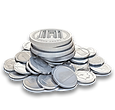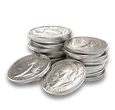How Market Sentiment and Trends Drive Auction Prices
- GoldsilverJapan

- Oct 4
- 5 min read
In the world of rare coins and precious metal collectibles, auction prices often seem unpredictable. Two coins of similar rarity, grade, and origin can sell for drastically different prices depending on when and where they're auctioned. Why does this happen?
One of the biggest—and most underestimated—drivers of coin auction prices is market sentiment. Just like stocks, real estate, or cryptocurrencies, the psychology of the market plays a huge role in determining value. In this in-depth article, we’ll explore how emotions, trends, hype cycles, media influence, and social proof can shape auction outcomes—and what collectors and investors should watch for in the years ahead.
🔍 What Is Market Sentiment?
Market sentiment refers to the overall attitude, mood, or feeling of investors and collectors toward a particular asset or the market as a whole. It is often emotional rather than rational, and it’s influenced by:
Economic news
World events
Interest rates
Cultural shifts
Social media and influencers
Past auction records
In coin auctions, sentiment can cause prices to spike well above the estimated market value—or plummet when confidence falters.
🧠 The Role of Psychology in Coin Auctions
1. Fear of Missing Out (FOMO)
When a rare coin gains media attention—such as breaking an auction record or being associated with a historical event—demand can skyrocket. Collectors rush to own “the next big thing,” even at inflated prices. This creates a bidding war.
Example: After a 1933 Double Eagle sold for $18.9 million in 2021, other Saint-Gaudens coins saw a surge in demand, even lower-grade examples.
2. Herd Mentality
Buyers tend to follow what others are doing. If a particular type of coin is trending (e.g., ancient Roman gold, modern proof coins, or rainbow-toned Morgan dollars), it can lead to inflated prices across the entire category.
Example: In 2020–2022, toned coins on eBay and major auction sites regularly sold for 50–300% premiums compared to non-toned equivalents, despite no difference in rarity.
3. Emotional Attachment
Coins tied to national identity, war, or family heritage often stir emotional bidding. These emotional triggers can cause collectors to overspend—especially when the coin is marketed with a compelling backstory.
🔥 Popularity Trends That Shape Auctions
1. Anniversaries and Commemorations
Historical anniversaries often drive demand for relevant coins. For example:
2022 marked 100 years since the discovery of King Tut’s tomb, and Egyptian-themed ancient coins surged in popularity.
2025 will mark 250 years since the American Revolutionary War began—expect colonial coins and Continental Currency to see renewed attention.
2. Celebrity or Media Exposure
When celebrities endorse coin collecting, or a rare coin appears in a Netflix documentary or news article, it can cause prices to spike.
In 2023, a YouTube video featuring an ultra-rare Roman gold coin led to a 300% price jump for similar coins within a few months.
Auction houses often capitalize on this by promoting coins with known provenance or media exposure.
3. Modern Hype Cycles
Even new releases can command absurd premiums due to hype. A good example is the 2022 Tudor Beasts gold coins, which sold out instantly on the Royal Mint’s website and fetched 2–3x retail on secondary markets within weeks.
📊 Case Study: Sentiment Over Time
Let’s look at a concrete example of how sentiment shifted over time for one coin:
Coin: 1909-S VDB Lincoln Cent (MS65 RD)
Year | Price | Notes |
2010 | $2,000 | Steady demand, moderate sentiment |
2015 | $1,600 | Market cooled due to over-supply |
2020 | $2,400 | Centennial nostalgia resurged |
2023 | $3,200 | YouTube & Instagram collectors hyped it up |
2024 | $2,700 | Slight dip post-hype, but still strong |
This coin’s fundamentals didn’t change—but collector mood did.
🧭 How to Interpret Sentiment as a Buyer or Seller
1. Monitor Social Media and Forums
Platforms like Reddit, YouTube, and Instagram are hotbeds of coin-collecting sentiment. Follow:
r/coins on Reddit
YouTube channels like Silver Dragons or CoinWeek
Collector communities on Discord
Trends often start here before moving into mainstream auction prices.
2. Analyze Auction Volume
If a specific coin suddenly floods the market, it's a sign that collectors are trying to "cash in" on a trend. Be wary of buying at this stage—it often signals a price peak.
3. Compare to Historical Averages
Use databases like PCGS Auction Prices, Heritage Auctions, and NumisMedia to compare a coin's recent selling price to its 3-, 5-, and 10-year averages. If it’s well above the norm, sentiment may be inflating the price.
💡 Strategic Tips for Collectors
✅ Buy During Lulls, Sell During Hype
Seasoned collectors know that markets are cyclical. When sentiment is low, prices often fall—even for fundamentally sound coins. That’s the time to buy.
✅ Don’t Chase the Herd
Avoid buying just because everyone else is. If the coin’s premium seems too high, it probably is. Stick to coins with solid fundamentals: low mintage, historical importance, high grade, and stable demand.
✅ Use Auctions to Your Advantage
Auction houses often feature trending coins with aggressive marketing. If you’re selling, this is a great time to list. If you’re buying, do your homework and know your price ceiling.
📈 Gold & Silver Premium Trends (2024–2025)
As of late 2024, gold is hovering around $3,800/oz, and silver is around $47/oz. These are significantly higher than their 2020 prices. However, many premium coin values haven’t caught up to the rising spot price.
What This Means:
Bullion-heavy coins (like 1 oz Britannias or Eagles) have gained in melt value.
Premium numismatic coins, like rare proofs or mint errors, may be underpriced relative to their gold content.
Strategy:
If you hold mostly bullion, it may be wise to:
Sell a portion while prices are high
Rotate into rare or high-grade coins that haven’t seen the same premium jump
Hedge against a future correction in spot prices
💥 Upcoming Trends to Watch for 2026
Digital Provenance
Coins with blockchain-based ownership or grading records may command higher trust and premiums.
Asia-Pacific Market Surge
More buyers from Japan, China, and South Korea are entering Western auctions. This global demand can drive up premiums for historically Western coins.
Women on Coins
Diversity movements have led to increased interest in coins featuring women (Liberty, Britannia, Cleopatra, etc.).
Pre-1933 Gold
With gold prices soaring, many are revisiting pre-1933 U.S. gold as both bullion and collectible assets.
Instagram Auctions
Some sellers now run live auctions on social media. While not “official,” these reflect sentiment in real-time and often set new informal benchmarks.
🧠 The Psychology Behind Bidding Wars
Auction formats (especially live or online timed bidding) are designed to amplify emotion. Here's how:
Countdown timers create urgency
Live updates play on competitiveness
Limited availability triggers scarcity response
High bidder visibility fuels ego-driven bids
Collectors can get carried away, especially for coins that “speak” to them emotionally—like coins from their birth year, country, or family heritage.
🛡️ Risk Management for Auction Buyers
To avoid overspending based on sentiment:
Set your max bid in advance
Avoid last-second emotional bidding
Get coins graded and authenticated post-purchase
Diversify your holdings
🤔 FAQs: Sentiment & Auction Pricing
Q1: Do social media trends affect auction prices?
Yes. Popular YouTubers, Reddit trends, and Instagram influencers can create spikes in demand.
Q2: Can coins lose value when sentiment fades?
Absolutely. Coins tied to short-lived hype cycles often drop once the attention shifts.
Q3: Should I wait for prices to fall before buying?
If you think a coin is overhyped, it’s often smart to wait. Most trend-driven premiums are temporary.
Q4: Are sentiment-driven auctions risky?
They can be. If you’re buying during peak hype, your resale value may fall if sentiment shifts.
Q5: How can I benefit from sentiment?
List your coins during peak excitement (anniversaries, news events) for maximum exposure and price.
🧭 Final Thoughts
Market sentiment is the invisible hand that often moves auction prices far more than condition or rarity alone. While fundamentals matter, never underestimate the emotional currents flowing through the numismatic market.
By studying trends, tracking hype cycles, and understanding collector psychology, you’ll be better equipped to:
Time your purchases
Maximize sale profits
Avoid costly emotional bidding
In the end, successful collecting and investing is about combining data with intuition—and learning to recognize when a coin’s price is driven by facts, or by the mood of the moment.











Comments